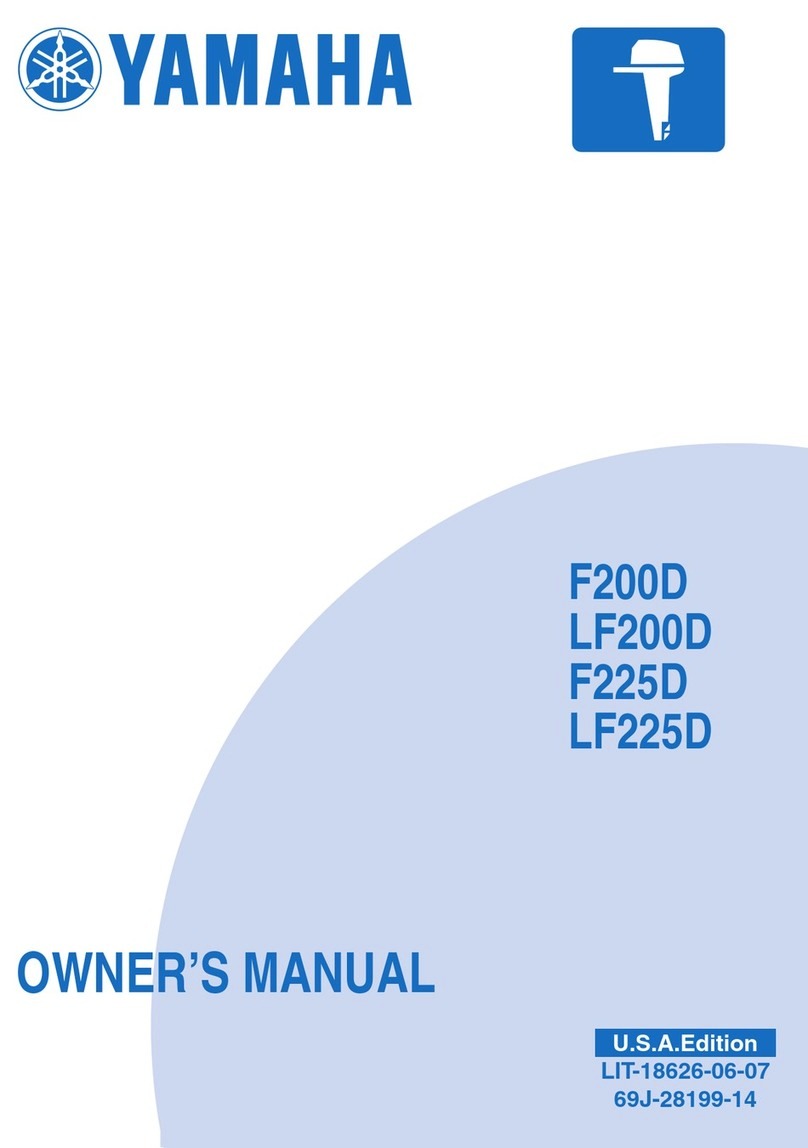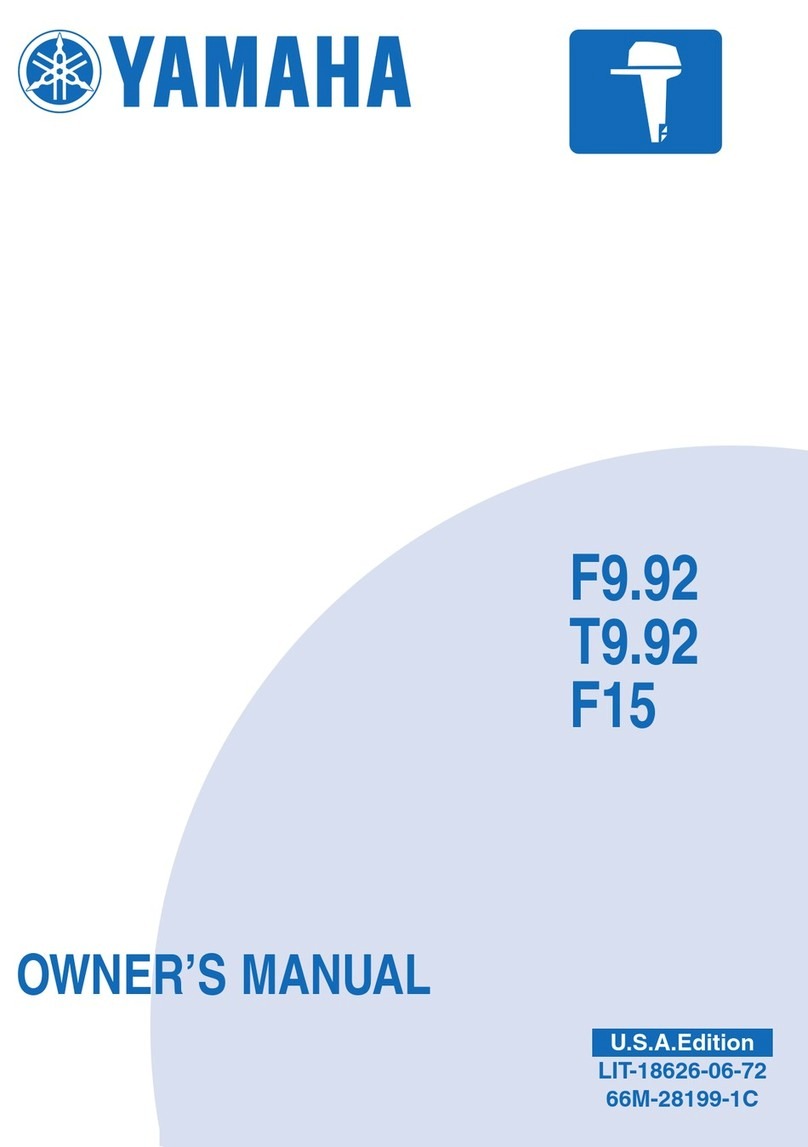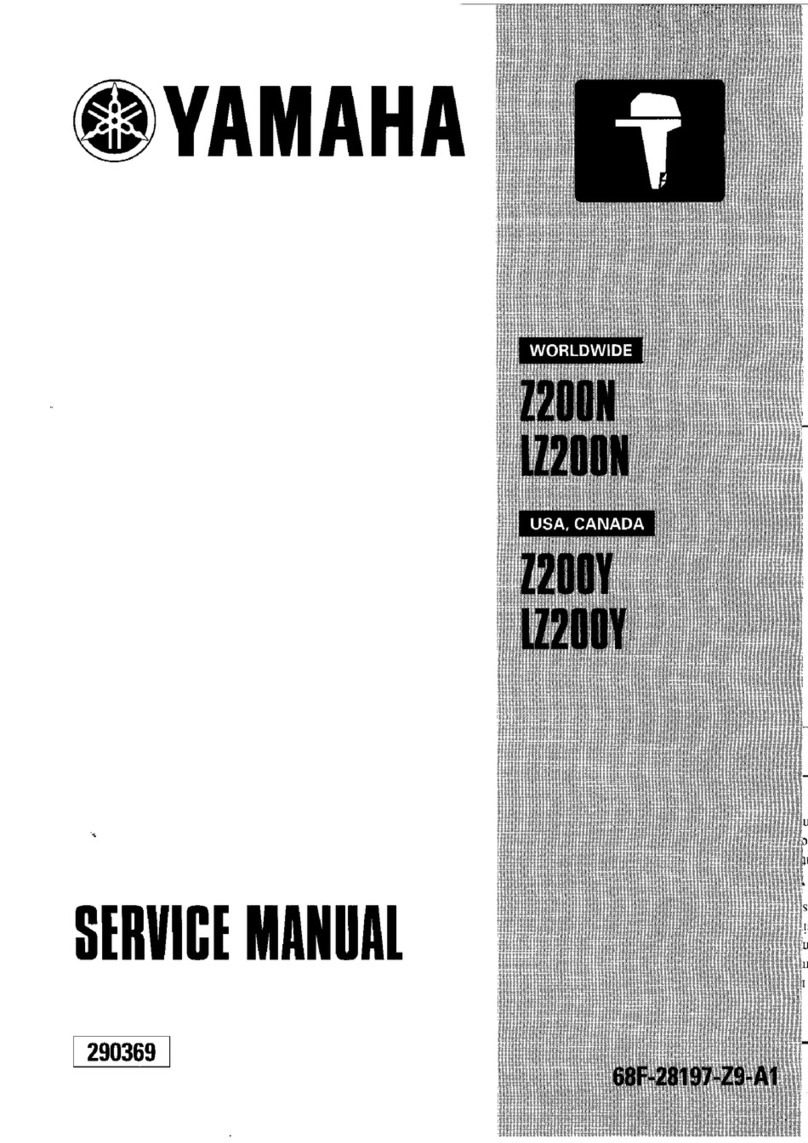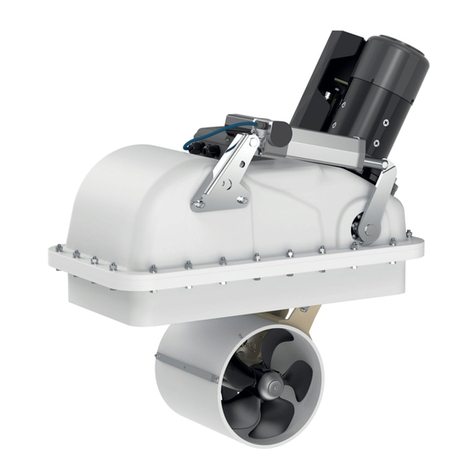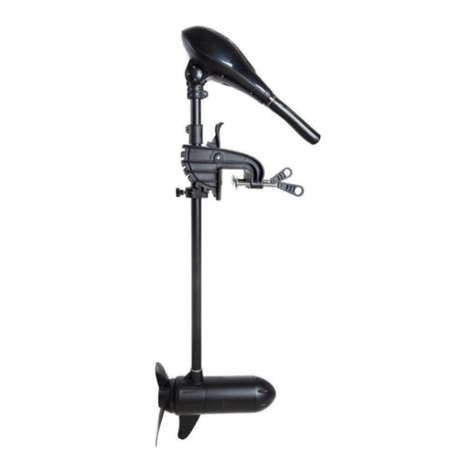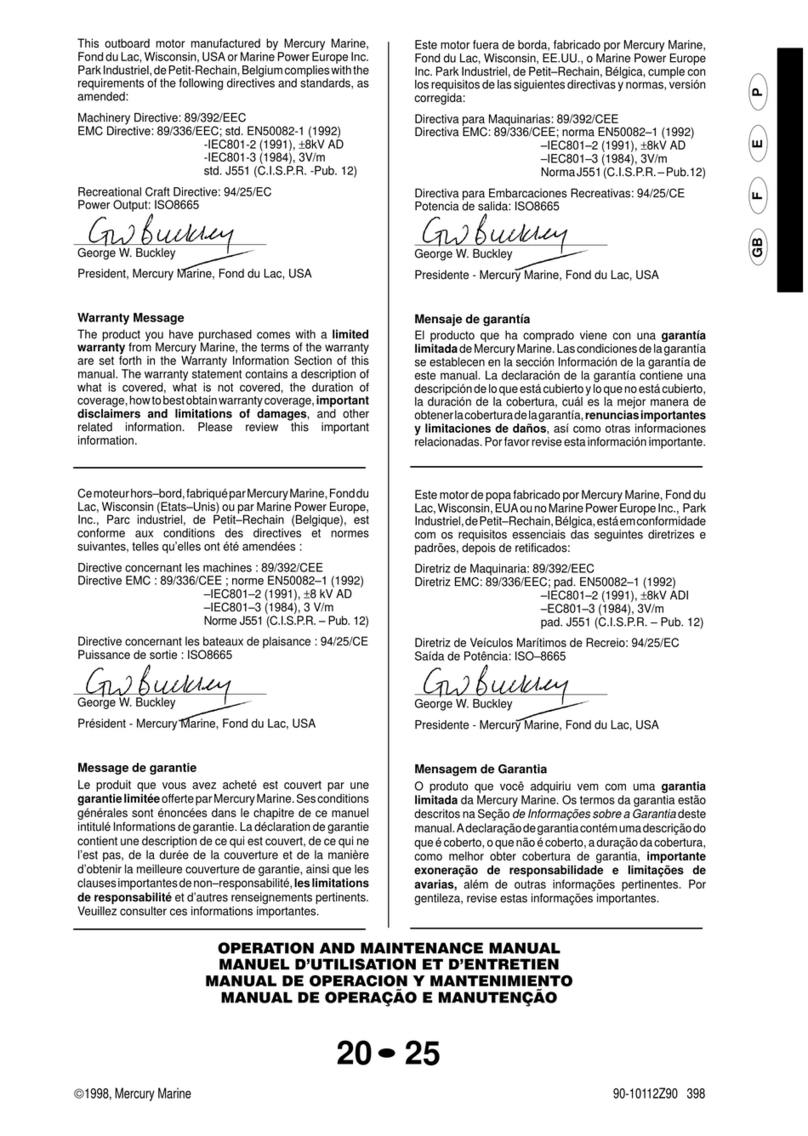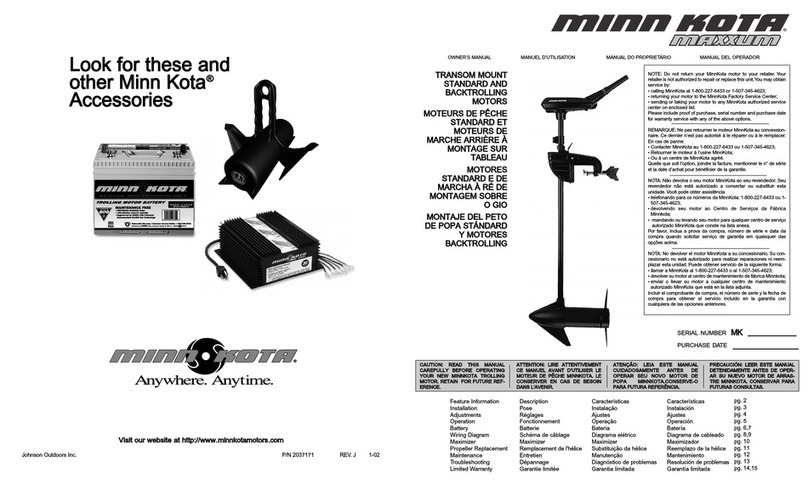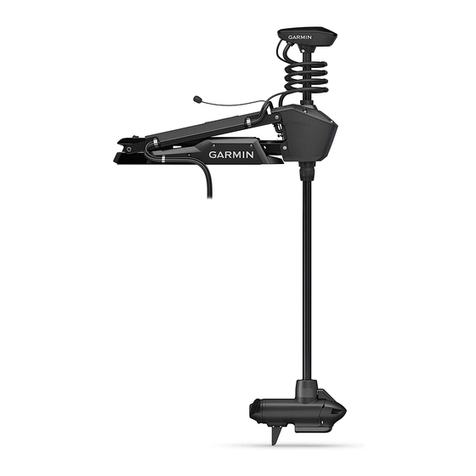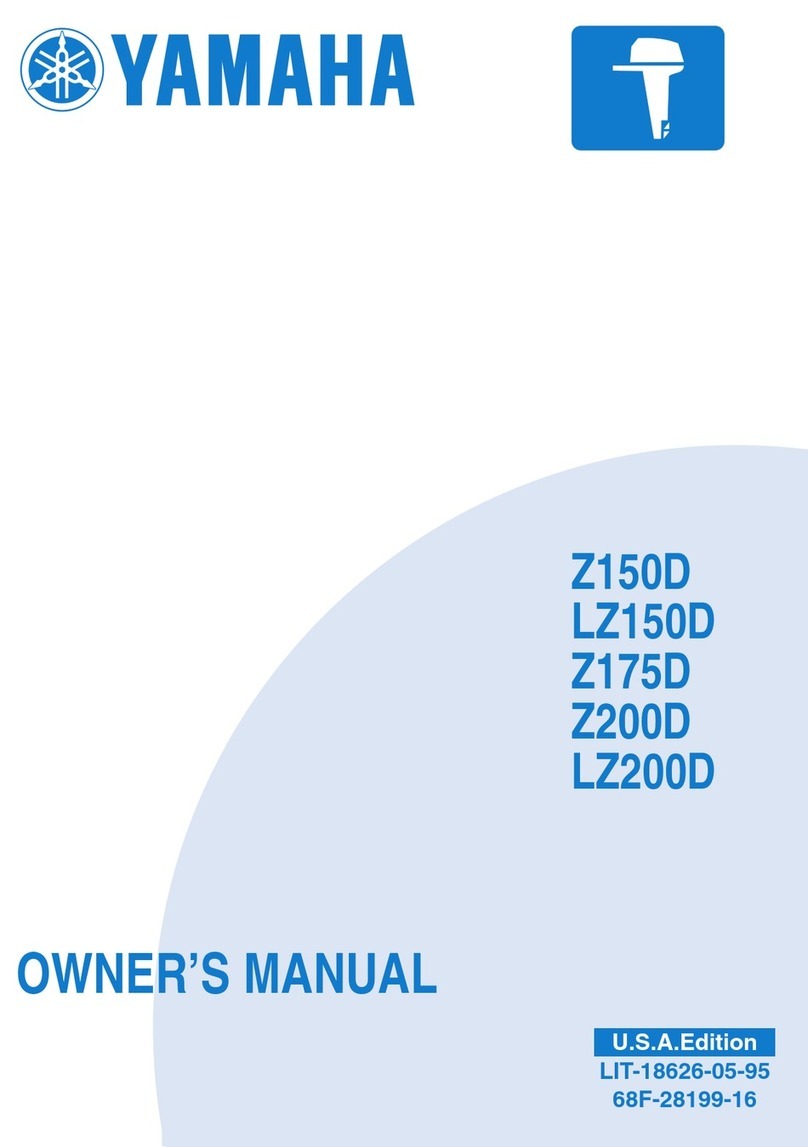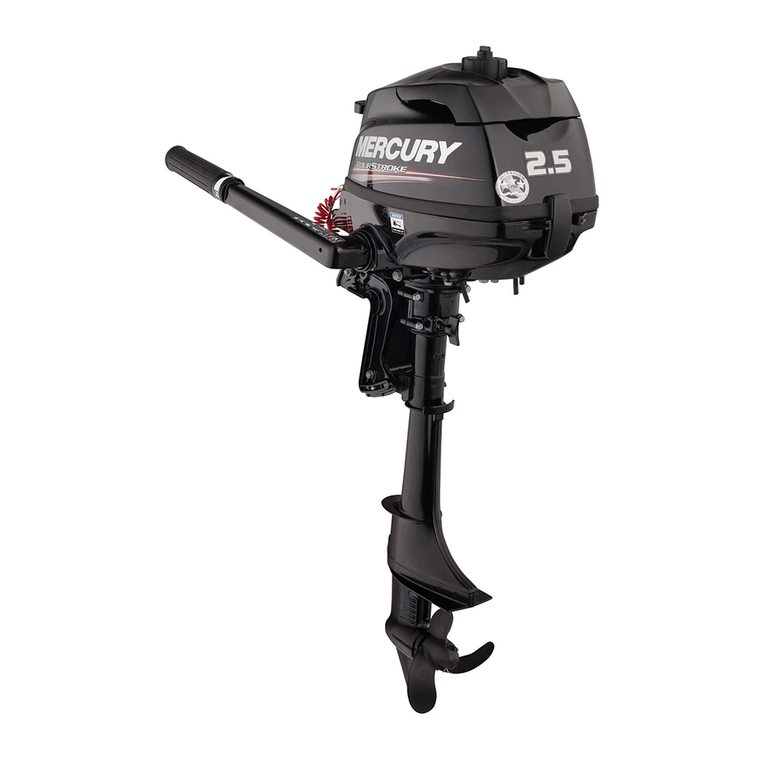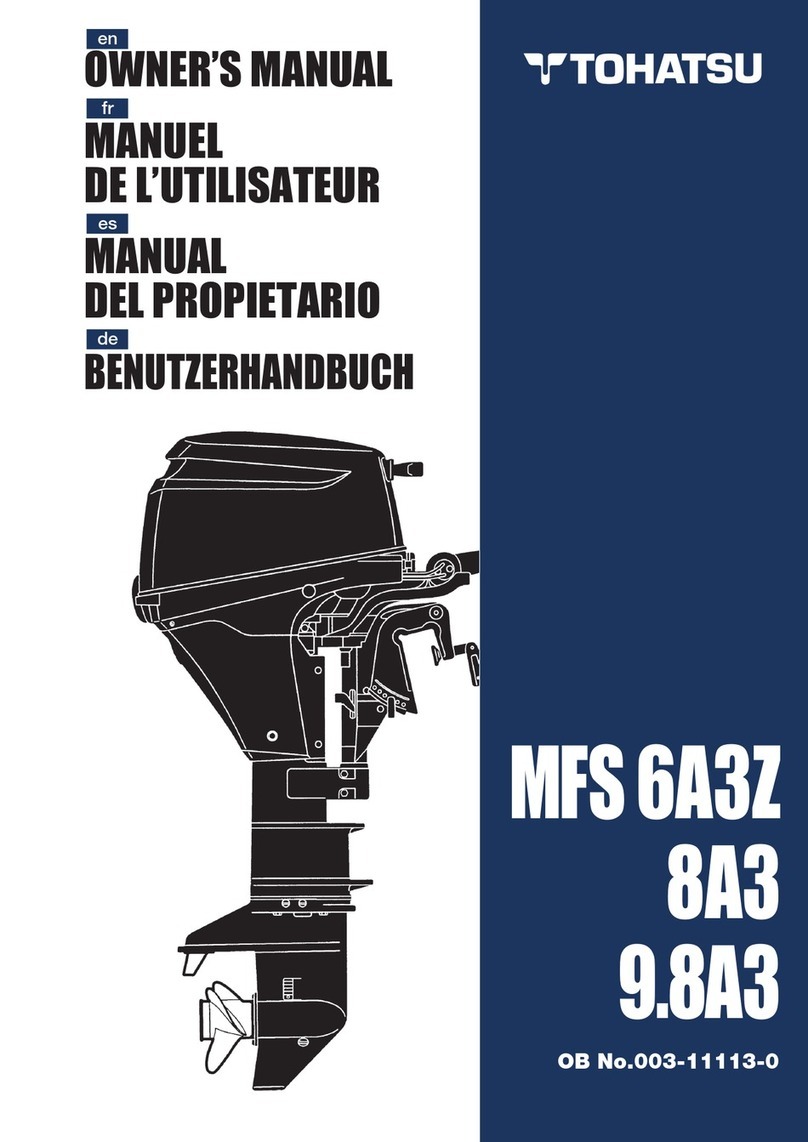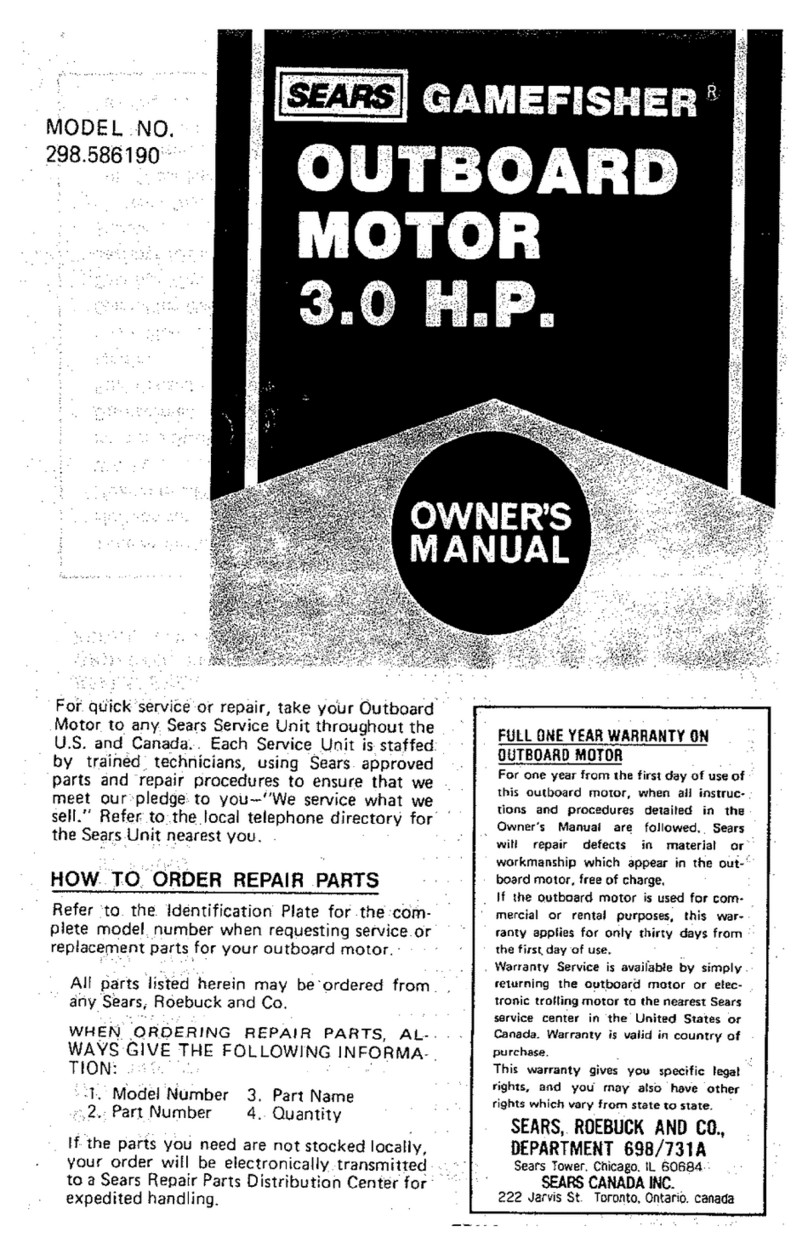GO-DEVIL SURFACE DRIVE FNR Operation manual

― INSTRUCTIONS ―
Operation and
Service Manual
May 2018
GO-DEVIL®Manufacturing Company of Louisiana LLC
(225) 752-0167 • Toll Free 1-888-490-3254 • Fax (225) 752-0175
18649 Womack Road • Baton Rouge, LA 70817
Please visit our website at www.godevil.com

SURFACE DRIVE SAFETY
•GASOLINE IS EXTREMELY FLAMMABLE! Always handle in properly approved containers.
Spilled fuel could ignite if it comes in contact with a hot engine or sparks!
•DO NOT LEAVE ANY FUEL TANK CONNECTED WHEN THE BOAT IS NOT IN USE.
TANKS SOLD AFTER JULY 2011 DO NOT HAVE A STANDARD VENT! Heat from the
suns radiation will build pressure inside the fuel tank and will force fuel through the carburetor
and into the crankcase. At this point the crankcase will become over full and will blow oil into
the air cleaner from the breather. After the air cleaner becomes saturated with oil, the fuel
mixture will become too rich and will foul the spark plugs.
•KEEP HANDS, FEET, HAIR, AND CLOTHING AWAY FROM ANY MOVING PARTS to
prevent accidents while engine is running both in the water and, most importantly, while on
land!
•WARNING!! –The trim knob is angled outward and away from a pinch point between the
engine and transom bracket. DO NOT PLACE HANDS BETWEEN ENGINE AND
TRANSOM BRACKET WHILE ENGINE IS RUNNING!!! If the skeg or prop strikes an
obstruction while underway, the engine may tilt violently and cause injury.
•NEVER TOUCH ENGINE COMPONENTS DURING OR IMMEDIATELY AFTER
OPERATION. Components can become extremely hot which could result in severe burns!
•NEVER RUN YOUR SURFACE DRIVE IN AN ENCLOSED AREA! Exhaust gases contain
poisonous carbon monoxide! Always test run in a well-ventilated area.
•ALWAYS OPERATE YOUR SURFACE DRIVE WITH THE SAFETY KILL SWITCH
LANYARD ATTACHED TO YOUR WRIST OR BELT LOOP! After warm up, always test your
safety kill switch to make sure it is operating properly!
•OPERATE YOUR SURFACE DRIVE FROM A SITTING POSITION, unless you install a grab
bar in your boat to operate while standing!
•BE ALERT FOR HAZARDS AT ALL TIMES! Shallow water areas in particular can present
a variety of challenges. Continually read the terrain for unexpected obstructions, turns, or
changes in water depth.
•KEEP YOUR SURFACE DRIVE IN A SAFE CONDITION. It is important to keep your engine
properly maintained. Having a breakdown can be difficult, especially if you are far away from
help or land. To help avoid problems, inspect your engine before each use and perform all
recommended maintenance.

TABLE OF CONTENTS
SURFACE DRIVE SAFETY
ASSEMBLY AND BOAT SETUP.................................................................................1-4
•Crate Removal.................................................................................................... 1-2
•Boat Setup....................................................................................................... 3-4
•Bolting Engine to Transom................................................................................. 3
OPERATION INSTRUCTIONS.................................................................................... 5-9
•Surface Drive Features........................................................................................ 5
•Launching, Engine Starting.................................................................................. 6
•Low Speed Operation.......................................................................................... 7
•High Speed Operation, Trim Adjustment........................................................... 7-8
•Reverse Operation on Go-Devil Surface Drive FNR…………………………….... 9
LUBRICATION......................................................................................................... 10-12
•Engine Lubrication............................................................................................. 10
•External Grease Fittings.................................................................................... 10
•Pressure Lubrication.......................................................................................... 11
•Internal Drive Lubrication................................................................................... 12
BELT TENSION AND INSTALLATION.................................................................... 13-15
•Tension Tester...How it Works!.......................................................................... 13
•Checking Belt Tension....................................................................................... 14
•Adjusting Belt Tension, Replacing belt................................................................ 15
SPECIAL TOOLS TO SERVICE SURFACE DRIVES………………………………….... 16
CHANGING TRANSMISSION OIL……………….…………………………………….…… 17
CLUTCH AND TRANSMISSION REMOVAL………………………………………..…18-19
CLUTCH AND TRANSMISSION INSTALLATION………………………………...….. 19-21
LOWER SEAL REPLACEMENT…………………………………………………………… 22
INSTALLING THE LOWER SEAL HOUSING……………………………………………. 23
PROPELLER REMOVAL/INSTALLATION……………………………………………….. 23
SHAFT REMOVAL/INSTALLATION………………………………………………………. 24
BUSHING REMOVAL AND INSTALLATION…………………………………………….. 25
SURFACE DRIVE FNR LOWER DRIVE ASSEMBLY…………………………………... 26
SERVICE MEMOS………………………….………………………………………………... 21
WARRANTY

1
TO THE NEW OWNER
Dear Customer,
You have just purchased one of the toughest pieces of marine equipment ever built. The
GO-DEVIL Surface Drive will give you many years of service with very little maintenance.
Of the few problems that occur, most are due to dirty fuel or not running the engine out of
fuel at the end of the season. We have found that unleaded gasoline will gum the
carburetor in a few months if your engine is not in use. We recommend adding a fuel
stabilizer such as Briggs & Stratton part number 100117(4oz) 100119A(32oz) to the fuel
in your last full tank of the season. Always disconnect the fuel hose from the tank and
run the engine completely out of fuel before storage if your engine has a carburetor!
Fuel injected engines do not need to be run out of gas but add stabilizer and
disconnect the battery and fuel tank. Fuel tanks should also be checked periodically
for water which may appear from condensation. We recommend using a transom
mounted water separating fuel filter (Sierra part # 18-7852-1 or equivalent) to collect water
before it reaches the engine.
ASSEMBLY AND BOAT SETUP
1. Lay the crated engine flat with the engine in a normal upright position.
2. Remove the plywood and 2x4’s surrounding the engine.
3. Locate the metal band holding down the prop end of the Surface Drive frame and
cut it with a pair of tin snips or remove the nails with a claw hammer.
4. Remove the plastic wrapping from the engine.
5. Inspect the engine for freight damage and contact our office immediately if
anything seems damaged. Note that the tail end of the skeg just in front of the
propeller is factory bent. This bend is designed to compensate for torque created
by the surfacing propeller.
6. Loosen the transom clamping studs located under the engine.
7. Locate the lifting eyes on the frame just below the muffler. Using the lifting eyes,
hoist the engine vertically from the crate and place it onto the transom of your boat.
8. Center the engine on the transom measuring from the outside gunnel rails of the
boat to the edges of the transom bracket. Tighten the clamping studs using a
crescent wrench or 1-1/16” wrench or socket (15/16” wrench for galvanized
models).
9. Remove the tiller handle from the frame by cutting all plastic tie-wraps that have
not been trimmed.

2
10. The 3/8”x 2-1/2” pivot bolt indicated by the arrow in (Fig. 1) is the pivot point for
the Adjustable/Floating handle. Remove the bolt and insert the handle into the
engine-mounted handle bracket. Reinstall the bolt into the bracket, passing it
through the hole at the end of the handle. Be sure to include the wire loom to
secure the cables as it was shipped. Install the washer and nut and tighten the nut
firmly or until a slight amount of drag can be felt while pivoting the handle up and
down from the grip.
37 hp Vanguard Shown
Check to ensure that the throttle linkage on the engine moves throughout its full
range when the throttle lever is depressed and that it returns to the idle position
when released.
Fig. 1
Pivot Bolt

3
For added safety, a stainless-steel throttle return spring has been installed on
engines with a carburetor during factory assembly. This spring returns the throttle
linkage to idle position when the squeeze lever is released. To ensure that the
throttle operates smoothly on engines with a carburetor, periodically lubricate the
throttle linkages with a WD-40 type spray lubricant. This is not necessary for an
EFI engine. For freezing temperatures, stand the handle in a vertical position and
inject antifreeze into the throttle cable with a hypodermic needle and work the
throttle back and forth. This will keep any moisture from freezing your throttle.
12. Bolt the engine to the transom as described below.
Looking from the rear of the engine, notice that the transom clamp has two
horizontal rows of holes. Either the two upper or two lower holes need to be used
to secure the engine to the transom. Four holes are provided to accommodate
various transom designs.
Using a 3/8” drill bit, drill through the lowest hole pattern on the bracket which
would allow the bolts to pass through a structural cross-member of the transom.
Install the two supplied 3/8” x 3” bolts, washers and nylon insert nuts. For Go-
Devil boats, the engine should be bolted to the transom using the two top holes.
ATTENTION: The Go-Devil Surface Drive
engine MUST BE BOLTED TO THE
TRANSOM!!!!! Failing to do so will cause
the transom clamp to loosen while
trailering, allowing the engine to possibly
fall off of the transom!!!!
BOLTS MUST PASS THROUGH A
STRUCTURAL CROSS-MEMBER OF THE
TRANSOM!!! (channel, tube, rib, etc.)

4
13. Tie a rope to the rib in your boat under the loop
welded on the underside of the Surface Drive
handle. Attach the clip provided with the engine to
the rope and use it to hold the Surface Drive
handle as shown in the picture to the right. This
clip should be used for launching your boat or any
time you need to hold the prop out of the water.
(It MUST not be used when the boat is being
trailered.)
14. Connect the battery cables to the battery. Attach
the red cable to the positive (+) side of the battery
and attach the black cable to the negative (-) side
of the battery. Make sure to tighten the battery
cables with a wrench and not just hand tight.
The battery should be kept in a covered battery
box secured to the floor of the boat and away from
gasoline vapors.
15. We recommend using a good nylon
rope to tie your boat instead of a boat
strap. Tie the rope to the trailer frame
on one side of the boat even with the
hand grip. Bring the rope over the
boat, then tie a loop in the rope before
the rope comes down the side of the
boat. Bring the rope around the trailer
frame and back up to the loop, cinch
the rope tight and tie it off.
This procedure will hold your boat as
tight as any boat strap so it will not
bounce when trailering. We also
recommend that you tie a red flag or
the Go-Devil Flag included with your purchase to the tail end of the Surface Drive
when towing your boat down the highway.
16. To tie down the engine for trailering use a ratchet strap attached to one boat handle
then make a wrap around the frame as shown above making sure not to wrap the
strap on top of the cover bolts and then attach the strap to the other boat handle
on the other side of the boat. Do not tie the Surface Drive FNR engine handle
down for any reason while trailering!

5
Surface Drive Features
SURFACE DRIVE FNR
OPERATION INSTRUCTIONS
ENGINE OIL
Fill the engine crankcase with the recommended amount and type of oil. With the engine
held perfectly level, check the oil level with the dip stick. Use a high detergent motor oil
of the same viscosity you are using in your car or truck for that time of the year. In warm
temperatures we recommend to use straight 30 weight oil. This will reduce oil
consumption.
Notice: For 23 Vanguard models it is important that the crankcase is not over filled with oil. Over
filling the crankcase will cause a decrease in vacuum at high speed, preventing the carburetor from
supplying an adequate amount of fuel to the engine. When this happens, the engine will starve for
fuel and temporarily lose performance. Ensure that the engine oil level does not exceed the full
level line on the dipstick.

6
FUEL
Fill the fuel tank with clean, fresh gasoline from a clean fuel can. Connect the fuel line
from the engine to the fuel tank and squeeze the primer bulb until firm. If the tank has a
vent (tanks sold before July 2011), the vent must stay open during operation. If you
purchased your tank July 2011 or after, disconnect your tank anytime it is not in use
because the tank does not have an open vent.
BASIC OPERATION
Launching
When launching your boat always leave the handle rope clipped with the shaft in a
horizontal position.
Before starting the engine on the water, always put on your life vest as you would in any
boat with any engine.
Attach the safety kill switch lanyard to your belt loop or wrist.
Starting the Engine
ALWAYS check engine oil level before starting!!
WARNING!!
Never run the engine in an enclosed area! Exhaust contains poisonous carbon
monoxide gas that may cause a loss of consciousness and/or death!
To Start the engine, FNR switch must be in the neutral (center position) to start. Pull the
choke rod to the choke position if your engine is a carbureted model. If you have an EFI
engine wait 5 seconds before starting. You will hear the fuel pump stop priming. Turn the
key to the start position. It maybe necessary to run the engine onchoke for a few seconds
until the engine warms up. You should run the engine for a few minutes to ensure that it
runs properly. If the engine runs rough after warm up, the carburetor may need
adjustment. (Refer to the engine Manual.)
To Stop the engine, release the throttle and allow the engine to idle for a few seconds.
Turn the key switch to the OFF position.
EMERGENCY STOP! The engine may be stopped at any time by pulling and detaching
the emergency kill switch lanyard from the kill switch. Note: It is the operator’s
responsibility to ensure that the kill switch operates properly before each use.

7
CAUTION! –Lowering the propeller into the water or shifting into forward at a high engine
rpm may cause a standing operator or passenger to lose balance or be ejected from the
boat. ALWAYS ALLOW THE ENGINE TO COME TO IDLE OR SHIFT INTO NEUTRAL
BEFORE LOWERING THE PROPELLER INTO THE WATER!
NOTE: AFTER YOUR FIRST TEST RUN ON THE WATER IT IS NECESSARY TO
REMOVE THE DRAIN PLUG (SHOWN ON PAGE 10) AT THE REAR OF THE DRIVE
HOUSING TO CHECK FOR WATER LEAKING IN. THIS BOX MUST RUN
COMPLETELY DRY. IF WATER COMES OUT OF THE DRAIN PLUG THE COVER
PLATES MUST BE REMOVED AND RE-SEALED WITH A GOOD GRADE SILICONE.
PERFORM THIS CHECK ANY TIME THE COVERS ARE REMOVED AND REPLACED.
Low Speed Operation
As described before, let the engine warm up for a few minutes. Holding the handle
carefully, remove the handle rope and get a feel for the balance of the engine.
For the first time operating your new Surface Drive engine, turn the trim adjustment knob
counterclockwise until the prop and cavitation plate can befully submerged while the boat
is floating at rest. Under normal conditions the trim can be adjusted for high speed
performance and does not need to be changed while idling or getting back up on plane.
Steer the engine slowly to avoid getting water into or overturning the boat. The
Go-Devil Surface Drive engine is better suited for wider bottomed boats (48” or wider).
Use extreme caution- even while idling -when making sharp turns on narrow boats.
To turn the boat around in a tight situation, allow the boat to nearly come to a complete
stop. While the engine is idling and in neutral, turn the engine all the way to one side and
shift into forward. Most boats will turn in their own length when this is done.
TIP! - Turning left at low speed requires less reach due to the handle being on the left
side of the engine. When reversing direction from rest or idle speed, set up to turn left
whenever possible. This will become instinctive with time.
High Speed Operation
As its name implies, the Go-Devil “Surface Drive”, uses a surface piercing propeller. The
surface propeller is designed to be run primarily with a fraction of each blade breaking the
surface of the water with each revolution. To get maximum performance from the engine,
propeller depth can be fine tuned using the manual trim.
The manual trim mechanism is a standard feature on all SD models. The trim is simply
a bottom stop on the tilt axis of the engine which allows the engine to tilt upward freely
when an underwater obstacle is struck.

8
Manual Trim Adjustment
WARNING!! –The trim knob is angled outward and away from a pinch point between the
engine and transom bracket. DO NOT PLACE HANDS BENEATH THE ENGINE WHILE
IT IS RUNNING!!! If the skeg or prop strikes an obstruction while underway, the engine
may tilt violently and cause injury. With the boat floating at rest, set the trim low enough
to fully submerge the propeller and cavitation plate below the waters surface. After getting
up on plane and to full throttle, take notice of the propeller depth.
Trim the engine up untilmaximum performance and comfort is achieved. Forthe average
boat and engine combination, the prop should be run with approximately 1/3 of its
diameter above the surface. (Shown below) Different hull designs and horsepower to
weight ratios will affect optimum propeller depth and performance while on plane. If
necessary, the drive ratio may be reduced to accommodate extremely large hulls and
loads.
Starting on May 15th, 2008 all Surface Drive Engines are equipped with an EZ Trim Lever.
The EZ Trim Lever allows the prop height to be dropped approximately 9” without
adjusting the manual trim knob. This allows a smooth and efficient transition between
your trim height for running on plane and “digging” out of a situation where you are stuck
or in extremely shallow water. Simply push down on the Surface Drive handle and flip
down the EZ Trim Lever to drop your prop height. After getting on plane and you are in a
sufficient water depth, push down on the Surface Drive handle again and flip the EZ Trim
Lever back up to come back to your normal trim height.
An engine mounted tachometer/hour meter is a highly recommended accessory since it
allows you to view both engine rpm and total run time. Maximum performance will
generally be achieved between 3400-3800 RPM since the engines make maximum
horsepower within this range. Idle RPM should be 1100-1200 out of the water and 900
RPMs in the water at idle.

9
Reverse Operation on Go-Devil Surface Drive FNR
After the engine warms up, shift the engine into reverse by pushing the FNR switch away
from you to power the electric brake and put the drive unit in reverse. The engine will back
up while the EZ Trim Lever is in the forward run position but you will have more power in
reverse when the E-Z Trim Lever is lowered. To lower the E-Z Trim Lever put the engine
in reverse and start to back up. Now depress the Surface Drive handle downward and
push the E-Z Trim Lever near the throttle backwards to let the prop down to the lower
position. This will allow the prop to drop about 9” to give you more power in reverse. When
you are ready to go forward, depress the handle downward and flip the E-Z Trim Lever
forward and flip the FNR switch back to the forward position. It is not necessary to shift
into reverse before depressing the Surface Drive handle but it will make it a little easier
to depress the Surface Drive handle while in reverse. It is preferred to bring the engine to
idle when shifting. (Illustrations below.) Operating the engine in reverse for an extended
period of time can generate a high heat situation and shorten the transmission’s oil life.
EZ Trim Control Lever Forward Position EZ Trim Control Lever Reverse Position
In the event of an electrical failure, you can use the emergency power supply to bypass
a failed electrical component and place the engine in a “direct drive” state that will allow
you to send 12 volts directly to the clutch and operate the engine in forward or to the
electric brake and operate in reverse. You must unplug both the electric brake
harness and clutch wiring harness if the emergency power supply is being used.
You will not have the option of neutral until you can repair the failed component and will
have to rely on raising the prop out of the water for “neutral”.
1. Remove the connector cover and
cut the tyraps holding all three
connectors together.
2. Remove the cap in the
emergency power supply and
unplug both of the other plugs.
Plug the emergency power
supply into the clutch wiring
harness plug and you can now
operate the engine in forward.
You must unplug both the electric brake harness and clutch
wiring harness if the emergency power supply is being used

10
LUBRICATION
ENGINE LUBRICATION
CHECK ENGINE OIL BEFORE EACH USE. We recommend changing engine oil after the first
10 hours on a new engine and every 50 hours or yearly after that. When changing oil, run the
engine to heat the oil before draining. When changing the oil filter always fill the filter with oil
before installing. Fill crankcase and then prime the oil pump by spinning the engine with the
electric starter for about 10 seconds with the safety kill switch in the kill position. Start the engine
and let it idle for a few minutes before speeding up.
Lubricate the engine’s throttle linkage on carbureted engines as needed with a WD-40 type spray
lubricant. This may or may not be necessary depending on environmental conditions. An
occasional spray will help keep the throttle functioning smoothly. EFI engines do not have any
linkage to lubricate.
EXTERNAL GREASE FITTINGS
The Surface Drive unit has 3external grease fittings which require periodic lubrication. One fitting
is located on the drive tube and the other two are located on the tilt axis and steering axis (see
photos below). We recommend using a #1 or #2 marine grade waterproof grease such as AQUA-
LUBE to lubricate all fittings.
Grease the steering and tilt axes after every 10-20 hours of run time. Any more often will be
excessive and messy. In addition to lubricating the fittings, apply a small amount of grease to the
transom clamp bolts yearly or as needed.
The fitting shown in the figure on the right below is used for lubricating the prop shaft and lower
bushing and seal system. A pressure lubricator shown to the left of the fitting feeds grease to
the system as needed and allows for heat expansion inside the drive tube. See the following
section on PRESSURE LUBRICATION on page 11 for proper lubrication and maintenance.
The drain plug shown is used to check for water leakage inside the frame housing. This should
be checked after your first test run on the water and again each time the panels are removed
and reinstalled. While the engine is out of the water, remove the plug and tilt the engine back
so that any water inside the housing will drain out of the drain hole. If water comes out when
checked, the panels should be resealed with a good grade silicone.
Grease Fittings
Drain Plug
Pressure
Lubricator
Serial
Number
Location

11
PRESSURE LUBRICATION
A pressure lubricator shown on the previous page is mounted on the upper end of the
drive tube and features a spring loaded piston which creates a small amount of grease
pressure inside the drive tube. This grease volume lubricates the prop shaft, lower bronze
bushing, and lower seals. During assembly the lubricator is intentionally oriented so that
the factory grease fitting is inaccessible. Lubricate ONLY the grease fitting mounted
adjacent to the lubricator to ensure that grease is fed into the drive tube and not just into
the lubricator. Pumping grease through this fitting will fill both the drive tube and the
lubricator.
•Visually inspect the position of the lubricator piston before and after each use.
•The lubricator should be kept about ¾ full so that grease consumption can be easily
monitored. The lower drive system should use up very little or no grease at all when
functioning properly.
•If the grease level does not seem to change after several hours of run time, pump grease into
the drive tube until the piston starts to rise. This ensures that the lubricator piston is not “stuck”
and giving a false impression that the tube is full. If the lubricator and drive tube are properly
filled, the piston should move upward after only a few pumps of grease.
•The lubricator cannot be damaged by over-lubricating the drive unit. The lubricator is
designed so that grease will expel from under the cap if over-filled.
•ATTENTION: The lubricator piston will not reach the bottom of the cup. When the piston
is at its lowest position, the visual grease column will be approximately 3/8” high. When the
piston reaches this level it will no longer supply grease to the tube. In order to insure proper
lubrication, the piston must be kept above this level at all times.
•IT IS THE CUSTOMER’S RESPONSIBILITY TO CHECK AND INSURE THAT THE
LUBRICATOR ISWORKING PROPERLY!! Remove and clean thelubricator yearly to ensure
that it is working properly and the piston is not stuck. If working properly, it should expel
grease from the bottom hole when removed.
•Do not clean the lubricator with a petroleum solvent such as gasoline, varsol, kerosene,
thinner, or carburetor cleaner. Petroleum solvents will destroy the plastic components. Wipe
excess grease with paper towels and clean components with mild dishwashing liquid.
SEAL AND BUSHING WEAR
As the lower and/or upper seals start to wear, the unit may start to consume more grease.
It may be time to replace the seals if the lubricator ever becomes empty after a normal
operation period or requires 10 pumps or more from the grease gun to fill on two
occasions. DO NOT DELAY THIS PROCEDURE!!! If the drive unit is run without grease,
premature wear on the prop shaft and lower bushing will occur and will elevate the cost
of repair. The life of the lower seals is determined by how the shaft is lubricated and how
abrasive the material is that the engine is run in, such as mud, sand, and silt. Under
extensive or commercial use, especially in brackish or salt water, the lower seals should
be replaced annually.

12
INTERNAL DRIVE LUBRICATION
The Surface Drive unit has 4 internal grease fittings located within the frame housing.
One fitting is located on each of the two universal joints and also on both the upper
bearing housing supporting the prop shaft and on the sprocket shaft bearing housing
shown in the photo below.
After every 75-100 hours of use, lubricate the upper bearing housing and the
universal joint fittings shown below with 2-3 pumps from a grease gun.
The Sprocket Shaft Bearing
Housing shown contains a set of
Tapered Roller Bearings. This
Housing is sealed and grease
lubricated.
After every 75-100 hours of use,
remove the clamp holding the vent
tube connected to the barb fitting
(Fig. 1) and pump grease into the
grease fitting until grease starts to
exit the top of the housing through
the vent hose. Collect excess
grease with a paper towel and
continue pumping grease into the
housing until clean grease starts to expel through the vent hose. Run the engine a few
minutes to mix the old grease with the new grease and kill the engine and pump with
grease again until new grease comes out of the vent tube. Repeat this process three
times and replace the vent tube clamp when finished.
Grease Fittings
Upper Bearing Housing
Grease Fitting
Sprocket
Replace the lower access
panel following the same
instructions as for the upper
panel described on the bottom
of page 15. Add an additional
amount of Silicone to the
corner areas where the bend in
the lower access panel mates
to the frame. Panels must be
sealed properly to keep water
out of the frame housing.
Set Screws
Vent hose
Fig. 1
Double U-Joint

13
BELT TENSION AND INSTALLATION
Gates Tension Testers
(Part# 7401-0076) are available
directly from Go-Devil or any
local Gates Dealer. (See page
14 for Instructions)
Gates Tension Tester...How it works!
The tension tester is pushed against the center of the belt width through the inspection
hole. Pencil type tension testers like this one measures belt tension by showing the force
required to deflect the belt a predetermined distance. Force and deflection on Surface
Drive Engines should be kept within the tolerance listed below. Belts that are run too loose
will cause an increase in driveline vibration resulting in reduced belt life. When
tensioning a new belt, adjust to the high end of the given tolerance to allow for belt
stretch. Never tension the belt more than specified! Over-tensioning the belt may
cause premature wear or damage to the engine and drive unit bearings. If checking
the tension on an existing motor target 17 lbs. for belt tension.
All FNR Models
Force = 13 - 21 lbs. (Target 17 lbs.) Deflection = 1/4”
TOOLS REQUIRED
Torque Wrench (to 250 Lbs.-In.)
3/8” Socket
9/16” Socket
6” long Socket Extension
3/8” Drive Ratchet
9/16” Wrench
11/16” Crowfoot or open end wrench
3/8” Drive universal joint
Gates Tension Tester
Gates Tension Tester
(Product No. 7401-0076)
- Up to 30 lbs. -
Deflection FORCE Scale
Deflection DISTANCE Scale
Sliding Rubber
“O” Ring

14
CHECKING BELT TENSION
Checking Belt Tension on the Surface Drive does not require removal of the rear access
panels. An inspection hole on the side of the frame is provided to inspect and check belt
tension from outside of the frame.
Belt tension should be checked every 30-50 hours of run time as described below and
readjusted if necessary.
1. Locate the black hole plug on the side of the frame behind the engine.
2. Carefully slip a knife blade behind the plug flange and pry it out of the hole.
3. Use a flashlight to look inside the hole and locate the belt. When using the tension
tester, force must be applied to the belt by pushing the tester in the center of the
belt width. The inspection hole may or may not be centered on the belt width.
4. Insert tension gauge (Gates # 7401-0076) through the
hole in drive housing and set large O-ring ¼” from the
frame. Be sure to use the inch scale and not the
metric scale on the tester. (Fig. 1)
5. Slide small O-ring against the large part of the gauge.
Make sure the tension gauge is in the middle of the belt.
Push the gauge in until the large O-ring touches the
housing. Remove the tester from the hole and view the
small sliding “O” ring location on the force scale. The
force applied to deflect the belt is indicated by the
location of the bottom of the “O” ring on the force scale.
(Fig. 2)
6. Repeat steps 4-5 at least three times or until you
achieve the same result for each measurement.
7. The desired tension is 13-21 pounds with a target of
17 pounds with 1/4” deflection on an existing belt
using Gates belt gauge # 7401-0076. If the belt
tension is less than 13 pounds it will be necessary
to adjust belt. Tension a new belt to 21 lbs. to allow
for stretching. A new belt will stretch over night without running the engine.
If the measured force falls below specs shown below, re-tension the belt as
described on the following page (15).
All FNR Models
Force = 13-21 lbs.
Deflection = 1/4”
Fig. 2

15
ADJUSTING BELT TENSION
1. To adjust the belt, remove the top panel and two
lower panels shown in Fig. 1. The lower panels are
sealed with Loctite 598 High Performance RTV
Silicone Gasket Maker. The panel will need to be pried
from the frame with a large screwdriver. (Fig. 1)
2. Loosen all eight frame housing bolts. (Fig. 2 has the
brake plate removed so you can see the bolts easier. It
is not necessary to remove the brake for belt
adjustment.) The top set of 3 bolts go into the back of
the engine. Loosen the two top bolts with the universal
joint, 6” extension, and 5/8” socket. (Fig. 3) The bottom
four hold the engine plate onto the frame. The lower
right of that set is a stud with a nut welded on it. It is a
lot easier to use an 11/16” crowfoot wrench on this bolt
but an open-end wrench can be used. Adjust the nuts
on the vertical 3/8” x 6” bolt to tighten the belt. Move
about 1/2 turn on the nut and recheck tension. Repeat
until desired tension is reached. When tension is
reached tighten all eight frame bolts to 250 in.-lbs. (21
ft.- lbs.) and recheck tension again. If it is too tight or
too loose adjust again.
3. NEW BELT ONLY - If installing a new belt, loosen the
lower adjustment nut and turn the Upper adjustment
nut clockwise to loosen the belt. Remove all four of the
3/8” bolts securing the sprocket shaft bearing housing
shown on page 12. The sprocket unit can then be lifted
enough to change the belt. Reinstall them with the new
belt in place around the sprocket. Torque all four bolts
to 250 In.-Lbs. (21 Ft.-Lbs.)
4. Remove all existing RTV Silicone from frame and
access panel and insure that mating surfaces are clean.
Apply a continuous 1/8” bead of silicone to the frame
surface and inside the bolt holes. Ensure that the bead is
continuous around the perimeter to prevent water leakage.
(Fig. 4)
5. Install the Access Panel and lightly tighten the 1/4” bolts.
Allow Silicone to cure for several hours and then torque all
bolts to 125 In.Lbs. (10Ft.- Lbs.)
6. After running your engine for the first time after sealing the
lower cover plates, remove the frame drain plug next to the
shaft housing to check for any water leakage. If any water
come out of the drain plug, you need to remove the lower
cover plates and re-seal it.
Remove
panels
Remove top
panel
Fig. 1
Fig. 2
Fig. 3
Fig. 4
11/16”
5/8”

16
SPECIAL TOOLS TO SERVICE SURFACE DRIVES
TOTAL $325.00
These tools can be rented for $20.00 plus shipping with a $325.00 deposit.
OTHER TOOLS NEEDED TO SERVICE FNR
SURFACE DRIVES
18” PIPE WRENCH
1/2” DRILL
8” OR 10” CRESCENT WRENCH
1-1/16” SOCKET OR COMBINATION WRENCH
1-1/8” DEEP SOCKET OR COMBINATION WRENCH
PAIR OF CHANNEL LOCK PLIERS
4 TO 5 LB HAMMER
5/16” DRILL BIT
1-1/4” X 6-1/2” LONG PVC PIPE (to install lower seals)
11/16” CROWFOOT (to loosen and tighten engine housing to frame)
½” x ¾” ADAPTER FOR SLIDE HAMMER (to remove transmission)
¾” SHAFT SLIDE HAMMER
2- ½” BOLTS 2 -1/2” long (to lock transmission when torqueing bolts)
3/16” HEX SOCKET DRIVER (to tighten brake disc bolts)
1/8” HEX SOCKET DRIVER (for transmission drain plug)
5/32” HEX SOCKET DRIVER (for installing transmission housing to sprocket)
TWO STRIPS OF .063” MATERIAL (for setting brake shoes)
NEVER SIEZE
BLUE LOCTITE
SYRINGE TO FILL GEARBOX
PART #
DESCRIPTION
USED FOR
PRICE
DIE114X1
1-1/4” HEX DIE
HEX DIE (TO REPAIR SHAFT TUBE THREADS)
$100
SHBUPU
PULLER FOR
SHAFT & BUSHINGS
(SLIDE HAMMER)
USED WITH:
SHAFT ADAPTER TO REMOVE SHAFT
BUSHING PULLER- TO REMOVE BUSHING-
(MUST USE 1-1/8” TAP TO THREAD INNER
BUSHING FOR BUSHING PULLER INSERTION.)
$50
SHAD
SHAFT ADAPTER
USED WITH PULLER TO REMOVE SHAFT
$15
BUPU1
BUSHING PULLER
USED WITH PULLER TO REMOVE BUSHING
$20
BUIN1
BUSHING INSTALLER
TO INSTALL BUSHINGS
$10
T118
1-1/8” TAP
USED TO THREAD INNER BUSHING FOR
INSERTION OF BUSHING PULLER FOR
REMOVAL OF BUSHING.
$60
R1
1” REAMER
AFTER BUSHING INSTALLATION, USED TO
REAM THE BUSHING FOR PROPER SHAFT
PLACEMENT/FIT.
$70

17
CHANGING TRANSMISSION OIL
1. Remove the top and rear cover
plates on drive housing. It is
not necessary to remove the
bottom cover plate that attaches
to the lubricator
guard. (Fig.1)
2. Place clean rags or paper towels
between the belt and
transmission to catch any oil you
may spill.
(Fig 2.)
3. Locate a fill/drain plug and rotate
that plug to 12 o’clock and remove
it using a 1/8” hex bit socket.
Remove the second plug which
will be at the six o’clock position to
drain the oil. Both plugs have to
be removed for the oil to drain.
(Fig 3.)
4. Using a cut off water bottle, drain
the oil. Reinstall one of the drain
plugs. (Fig. 4.)
5. Fill the transmission with the
supplied syringe and 1.5 oz of
Mobil 1 4T 10W-40 Racing Oil
and install the second drain plug.
Change the oil every 100 hours
when you service the sprocket
shaft bearings and u-joints.
(Fig. 5)
6. Reinstall the covers using a good
grade RTV silicone on the back
cover. (Fig. 6)
7. After running your engine for the
first time after sealing the lower cover plates, remove the frame drain
plug next to the shaft housing to
check for any water leakage. If any
water come out of the drain plug, you
need to remove the lower cover plates
and re-seal it.
100 hours is the recommended oil change interval for the transmission under
normal conditions. If your engine is being used excessively in reverse you
should change the oil every 50 hours.
Seal with RTV
Fig. 3
Fig. 1
Fig. 4
Fig. 5
Fig. 6
Fig. 2
Table of contents
Other GO-DEVIL Outboard Motor manuals

